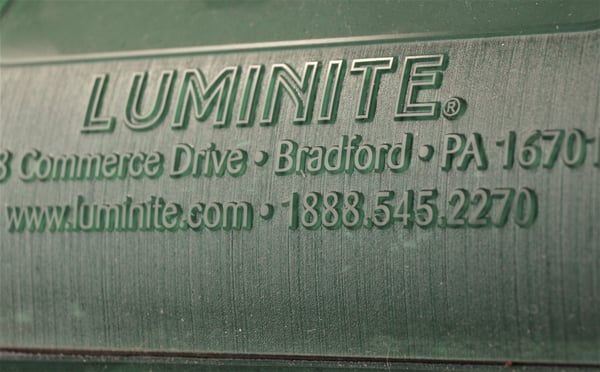Share this
Flat Top Dots: What to Talk To Your Image Carrier Manufacturer About
by Luminite on Mar 22, 2022 10:00:00 AM

In the flexographic printing world, paying attention to the tiniest of details can make the biggest of differences. One small detail that requires attention is dot profiles ( or shapes).
It seems simple enough to overlook, but the experienced flexo printing pro knows that the implications behind using different image carrier dot profiles can drastically affect the quality of the finished prints.
Why Do Flexo Dot Profiles Matter?
There can be two different dot profiles – flat or round – which will have an impact on the final printed product.
The choice of dot profile is based on many factors including:
- Ink characteristics
- Desired color density
- Image
- Substrate
4 Key Factors in Deciding What Dot Profile Is Best For Your Print:
When talking to your image carrier supplier, here are some considerations to discuss so that they can help decide what’s best for you:
-
Impression Levels
Roundtop dots will produce varying final print results depending on the printing pressure. Without knowing what’s best for your print, this can lead to significant dot deformation or unpredictable dot gain.
Roundtop dots have the ability to print a finer, smaller dot due to the rounded contact point and are often used for highlight or detail areas.
A flat-top dot has a defined surface which leads to less variability in dot gain based on pressure and increased benefits for solid, dense ink areas and reverse printing projects -- especially for printing jobs involving flexible or corrugated substrates.
They also allow more ink to be transferred to the substrate from the image carrier. The steep dot shoulders allow for greater image carrier floor depth - even when the dots are close to each other in dense printing areas.
2. Printing Results
Roundtop dots are highly sensitive to change under pressure, which can cause problems in certain print jobs. As the printing pressure is increased, the color density can change rapidly.
Flat top dots are less impacted by pressure on the press, so a higher degree of image consistency can be achieved throughout the press run.
The flat-top dots manage to maintain a far crisper edge and a better-defined printing surface. They are known for providing an optimal dot structure, resulting in improved color control for increased vibrancy.
3. Effect on Image Carrier Stress
Flat top dots are generally considered to be the more durable dot, which can lead to a significantly longer image carrier life than rounded dots.
4. Cost Considerations
Flat top dot image carriers yield longer press life and more consistent prints, which can increase profitability.
Where Dot Profile Is Headed
Ever-improving dot technology will enable flexo printers to expand their printing capabilities into more products that are currently performed by offset or gravure printers. Items such as high-end labels, cartons, and flexible packaging can be printed using the flexographic process.
With a solid understanding of the key aspects of the flexographic printing process such as ink choice, dot profile, image carrier, and ink transfer – printers have the opportunity to produce higher quality images now more than ever before.
Editor's Notes: This blog post was originally published in September 2018 and updated in March 2022 to reflect recent information for our readers.
Share this
- Flexographic Printing (81)
- Image Carrier (28)
- Elastomer sleeves (27)
- Ink Transfer (25)
- Quality (22)
- Flexo sleeve (20)
- News (18)
- printing defects (18)
- flexo printing defects (17)
- sustainability (13)
- Flexo Troubleshooting (12)
- Ink (12)
- Digital Printing (10)
- Flexo 101 (10)
- Flexo Inks, (9)
- Anilox (7)
- Blister Packaging (7)
- Cost (6)
- print misregistration (6)
- regulations (6)
- Corrugated Printing (4)
- pinholing (4)
- "Tradeshow (3)
- Digital Flexo (3)
- Gravure Printing (3)
- Insider (3)
- Load-N-Lok (3)
- Wide Web (3)
- direct laser engraving (3)
- flexo-equipment-accessories (3)
- gear marks (3)
- halo (3)
- testing (3)
- Narrow Web (2)
- bridging (2)
- feathering (2)
- filling in (2)
- mottled image (2)
- pressure (2)
- Labelexpo (1)
- dirty prints (1)
- doughnuts (1)
- embossing (1)
- kiss impression (1)
- October 2023 (2)
- September 2023 (1)
- August 2023 (1)
- July 2023 (3)
- June 2023 (1)
- May 2023 (5)
- April 2023 (1)
- March 2023 (2)
- February 2023 (1)
- January 2023 (3)
- December 2022 (1)
- October 2022 (3)
- September 2022 (2)
- August 2022 (2)
- July 2022 (3)
- May 2022 (1)
- April 2022 (4)
- March 2022 (2)
- February 2022 (5)
- January 2022 (7)
- December 2021 (1)
- November 2021 (3)
- October 2021 (2)
- September 2021 (1)
- August 2021 (1)
- July 2021 (3)
- June 2021 (1)
- May 2021 (4)
- April 2021 (4)
- March 2021 (4)
- February 2021 (2)
- December 2020 (1)
- November 2020 (1)
- October 2020 (2)
- September 2020 (1)
- August 2020 (3)
- July 2020 (2)
- June 2020 (3)
- May 2020 (1)
- April 2020 (1)
- November 2019 (3)
- October 2019 (1)
- August 2019 (1)
- July 2019 (1)
- April 2019 (1)
- March 2019 (1)
- January 2019 (1)
- October 2018 (2)
- August 2018 (1)
- July 2018 (1)
- June 2018 (1)
- February 2018 (2)
- October 2017 (1)
- September 2017 (2)
- January 2016 (1)
- February 2015 (1)
- January 2015 (1)
- December 2014 (2)
- September 2014 (1)
- February 2014 (1)
- January 2014 (1)
- December 2013 (3)
- October 2013 (1)
- September 2013 (1)
- June 2013 (1)
- January 2013 (1)


Comments (2)